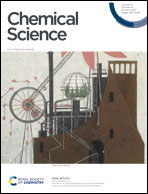A convergent fragment coupling strategy to access quaternary stereogenic centers†
Abstract
The formation of quaternary stereogenic centers via convergent fragment coupling is a longstanding challenge in organic synthesis. Here, we report a strategy for the formation of quaternary stereogenic centers in polycyclic systems based upon the semi-pinacol reaction. In the key transformation, two fragments of a similar size and complexity are joined by a 1,2-addition of an alkenyl lithium to an epoxy ketone, and the resulting epoxy silyl ether undergoes a semi-pinacol rearrangement catalyzed by N-(trimethylsilyl)bis(trifluoromethanesulfonyl)imide (TMSNTf2) or trimethylsilyl trifluoromethanesulfonate (TMSOTf). Polycyclic scaffolds were generated in high yields and the reaction conditions tolerated a variety of functional groups including esters, silyl ethers, enol ethers, and aryl triflates. This method provides a useful strategy for the synthesis of complex polycyclic natural product-like scaffolds with quaternary stereogenic centers from simplified fragments.



 Please wait while we load your content...
Please wait while we load your content...